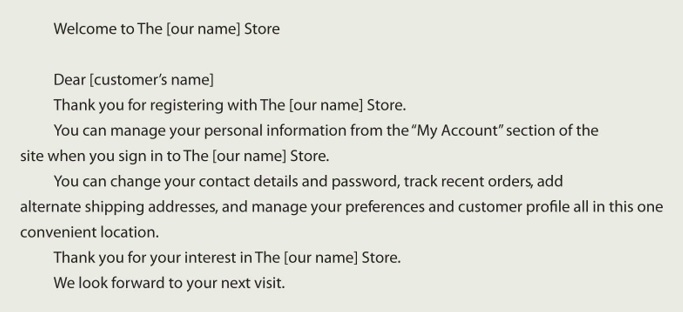10.3 Workplace Communication
Learning Objectives
By the end of this section, you will be able to:
- Differentiate between formal and informal language.
- Discuss the role of text messaging and e-mails in business communication.
- Describe the appropriate use of netiquette.
Oral and written communication proficiencies are consistently ranked in the top ten desirable skills by employer surveys year after year. In fact, high-powered business executives sometimes hire consultants to coach them in sharpening their communication skills. According to the National Association of Colleges and Employers (2009), the following are the top five personal qualities or skills potential employers seek:
- Communication skills (verbal and written)
- Strong work ethic
- Teamwork skills (works well with others, group communication)
- Initiative
- Analytical skills
Knowing this, you can see that one way for you to be successful and increase your promotion potential is to increase your abilities to speak and write effectively (Figure 10.9).

The College Board (2004) found that writing is related to attaining high-skill, high-wage work. Not being able to clearly articulate yourself can limit your opportunities for professional, salaried employment. unable to express themselves clearly in writing limit their opportunities for professional, salaried employment. An individual with excellent communication skills is an asset to every organization. No matter what career you plan to pursue, learning to express yourself professionally in speech and in writing will help you get there. Let’s examine the various ways communication is used in the workplace today.
Language Use
In the workplace, the type of language and how we use language is essential. PayScale (2016) surveyed 63,924 managers. The top 3 Hard-Skills managers reported that new college graduates lack are writing proficiency (44%), public speaking (39%), and data analysis (36%). The top 3 Soft Skills the managers reported that new college graduates lack are critical thinking/problem-solving (60%), attention to detail (56%), and communication (46%). One of the most important factors of professionalism in today’s workplace is effective written and oral communication. From the moment someone sends in a resume with a cover letter, their language skills are being evaluated, so knowing how to use both formal language effectively and jargon/specialized language is paramount for success in the workplace.
Formal Language
Formal language is a specific writing and spoken style that adheres to strict conventions of grammar. This is in contrast to informal language, which is more common when we speak. In the workplace, there are reasons why someone would use both formal and informal language. Formal language is less personal and more professional in tone than informal language. Some key factors of formal language include complex sentences, use of full words, and the third person.
Informal language, on the other hand, is more colloquial or common in tone; it contains simple, direct sentences; uses contractions and abbreviations, and allows for a more personal approach that includes emotional displays. For people entering the workplace, learning how to navigate both formal and informal language is very beneficial because different circumstances will call for both in the workplace. If you’re writing a major report for shareholders, then knowing how to use formal language is very important. On the other hand, if you’re a PR professional speaking on behalf of an organization, speaking to the media using formal language could make you (and your organization) look distant and disconnected, so using informal language can help in this case.
Use of Jargon/Specialized Language
Every industry is going to be filled with specialized jargon or the specialized or technical language particular to a specific profession, occupation, or group that is either meaningless or difficult for outsiders to understand. For example, if you were informed that a “factor analysis with a varimax rotation” was conducted, you would likely be confused. However, those who study human communication from a social scientific perspective, would know what that phrase means because they learned it during their training in graduate school. If you walked into a hospital and heard an Emergency Department (ED) physician referring to the GOMER in bay 9, most of you would be equally perplexed. Every job has some jargon, so part of being a professional is learning the jargon within your industry and peripherally related sectors as well. For example, if you want to be a pharmaceutical sales representative, learning some of the jargon of an ED (notice they’re not called ERs anymore). Trust us, watching the old television show ER isn’t going to help you learn this jargon very well either (Primack, et al., 2012).
Instead, you have to spend time within an organization or field to pick up the necessary jargon. However, you can start this process while a student by joining student groups associated with specific fields. If you want to learn the jargon of public relations, join the Public Relations Student Society of America. If you want to go into training and development, becoming a student member of the Association for Talent Development. Want to go into nonprofit work, become a member of the Association for Volunteer Administration or the Young Nonprofit Professionals Network. If you do not have a student chapter of one of these groups on your campus, then find a group on LinkedIn or another social networking site aimed at professionals. One of the great things about modern social networking is the ability to watch professionals engaging in professional dialogue virtually. By watching the discussions in LinkedIn groups, you can start to pick up on the major issues of a field and some of the everyday jargon.
Texting
Text messages and e-mails are part of our communication landscape, and skilled business communicators consider them a valuable tool to connect. Netiquette refers to etiquette, or protocols and norms for communication, on the Internet.
Whatever digital device you use, written communication in the form of brief messages, or texting, has become a common way to connect. It is useful for short exchanges, and is a convenient way to stay connected with others when talking on the phone would be cumbersome. Texting is not useful for long or complicated messages, and careful consideration should be given to the audience.
It is often said that you can tell how old someone is by how he or she inputs a phone number on a cell phone. If the person uses his or her thumb while holding the digital device, that person may have been raised on video games and be adept at one-handed interfaces. If he holds the digital device with one hand and inputs the number with the other, he may be over thirty, or may be less comfortable with some technological devices. Of course, there is no actual correlation between input and age, but it is a useful example to use when considering who your audience is when writing a text message. If the person is a one-hander, and knows all the abbreviations common to texting, you may be able to use similar codes to communicate effectively. If the person is a two-hander, you are better off using fewer words and spelling them out. Texting can be a great tool for connecting while on the go, but consider your audience and your company, and choose words, terms, or abbreviations that will deliver your message (Figure 10.10).

Tips for Effective Business Texting
- Know your recipient; “? % dsct” may be an understandable way to ask a close associate what the proper discount is to offer a certain customer, but if you are writing a text to your boss, it might be wiser to write, “what % discount does Murray get on $1K order?”
- Anticipate unintentional misinterpretation. Texting often uses symbols and codes to represent thoughts, ideas, and emotions. Given the complexity of communication, and the useful but limited tool of texting, be aware of its limitation and prevent misinterpretation with brief messages.
- Contacting someone too frequently can border on harassment. Texting is a tool. Use it when appropriate but don’t abuse it.
- Unplug yourself once in a while. Do you feel constantly connected? Do you feel lost or “out of it” if you don’t have your cell phone and cannot connect to people, even for fifteen minutes? Sometimes being unavailable for a time can be healthy, everything in moderation, including texting.
- Don’t text and drive. Research shows that the likelihood of an accident increases dramatically if the driver is texting behind the wheel (Houston Chronicle, 2009). Being in an accident while conducting company business would reflect poorly on your judgment as well as on your employer.
Electronic mail, usually called e-mail, is quite familiar to most students and workers. It may be used like text, or synchronous chat, and it can be delivered to a cell phone. In business, it has largely replaced print hard copy letters for external (outside the company) correspondence, as well as taking the place of memos for internal (within the company) communication (Guffey, 2008). E-mail can be very useful for messages that have slightly more content than a text message, but it is still best used for fairly brief messages.
Many businesses use automated e-mails to acknowledge communications from the public, or to remind associates that periodic reports or payments are due (Figure 10.11). You may also be assigned to “populate” a form e-mail in which standard paragraphs are used but you choose from a menu of sentences to make the wording suitable for a particular transaction.

E-mails may be informal in personal contexts, but business communication requires attention to detail, awareness that your e-mail reflects you and your company, and a professional tone so that it may be forwarded to any third party if needed (Figure 10.12). E-mail often serves to exchange information within organizations. Although e-mail may have an informal feel, remember that when used for business, it needs to convey professionalism and respect. Never write or send anything that you wouldn’t want read in public or in front of your company president.

Tips for Effective Business E-mails
- Proper salutations should demonstrate respect and avoid mix-ups in case a message is accidentally sent to the wrong recipient. For example, use a salutation like “Dear Ms. X” (external) or “Hi Barry” (internal).
- Subject lines should be clear, brief, and specific. This helps the recipient understand the essence of the message. For example, “Proposal attached” or “Your question of 10/25.”
- Close with a signature. Identify yourself by creating a signature block that automatically contains your name and business contact information.
- Avoid abbreviations. An e-mail is not a text message, and the audience may not find your wit cause to ROTFLOL (roll on the floor laughing out loud).
- Be brief. Omit unnecessary words.
- Use a good format. Include line breaks between sentences or divide your message into brief paragraphs for ease of reading. A good e-mail should get to the point and conclude in three small paragraphs or less.
- Reread, revise, and review. Catch and correct spelling and grammar mistakes before you press “send.” It will take more time and effort to undo the problems caused by a hasty, poorly written e-mail than to get it right the first time.
- Reply promptly. Watch out for an emotional response—never reply in anger—but make a habit of replying to all e-mails within twenty-four hours, even if only to say that you will provide the requested information in forty-eight or seventy-two hours.
- Use “Reply All” sparingly. Do not send your reply to everyone who received the initial e-mail unless your message absolutely needs to be read by the entire group.
- Avoid using all caps. Capital letters are used on the Internet to communicate emphatic emotion or yelling and are considered rude.
- Test links. If you include a link, test it to make sure it is complete.
- E-mail ahead of time if you are going to attach large files (audio and visual files are often quite large) to prevent exceeding the recipient’s mailbox limit or triggering the spam filter.
- Give feedback or follow up. If you don’t get a response in twenty-four hours, e-mail or call. Spam filters may have intercepted your message, so your recipient may never have received it.
Netiquette
We create personal pages, post messages, and interact via mediated technologies as a normal part of our careers, but how we conduct ourselves can leave a lasting image, literally. The photograph you posted on your Facebook or Instagram may have been seen by your potential employer, or that nasty remark in a post may come back to haunt you later. When the Internet was a new phenomenon, Shea (1994) laid out a series of ground rules for communication online that continue to serve us today.
Virginia Shea’s Rules of Netiquette
- Remember the human on the other side of the electronic communication.
- Adhere to the same standards of behavior online that you follow in real life.
- Know where you are in cyberspace.
- Respect other people’s time and bandwidth.
- Make yourself look good online.
- Share expert knowledge.
- Keep flame wars under control.
- Respect other people’s privacy.
- Don’t abuse your power.
- Be forgiving of other people’s mistakes.
Her rules speak for themselves and remind us that the golden rule (treat others as you would like to be treated) is relevant wherever there is human interaction.
Summary
- Differentiate between formal and informal language.
- A text message is a brief written message sent and received using a digital device. It is useful for informal, brief, time-sensitive communication.
- E-mail is useful for both internal and external business communications. The content and formatting of an e-mail message should reflect professionalism and follow the rules of netiquette.
- Social customs that exist in traditional, live, human interaction also influence the rules and customs by which we interact with each other in the online environment.
Discussion Questions
- Choose at least three e-mails you have sent or received that are good examples of business communication. What makes them good examples? Could they be improved in any way? Share your suggestions with classmates.
- In your experience, how do people behave when they interact online? Share your observations with your classmates.
Remix/Revisions featured in this section
- Editing revisions to tailor the content to the Psychology of Human Relations course.
- Remix of Chapter 13: Interpersonal Relationships at Work (Interpersonal Communication – Milne Library) added to 1 Why Is It Important to Communicate Well? and 9.1 Text, E-mail, and Netiquette (Business Communication for Success – University of Minnesota).
- Added images and provided links to locations of images and CC licenses.
- Added doi links to references to comply with APA 7thedition formatting reference manual.
Attributions
CC Licensed Content, Original
Modification, adaptation, and original content. Provided by: Stevy Scarbrough. License: CC-BY-NC-SA 4.0
CC Licensed Content Shared Previously
Business Communication for Success. Authored by: University of Minnesota. Located at: https://open.lib.umn.edu/businesscommunication/ License: CC-BY-NC-SA 4.0
CC Licensed Content Shared Previously
Interpersonal Communication: A Mindful Approach to Relationships Authored by: Jason S. Wrench; Narissra M. Punyanunt-Carter; and Katherine S. Thweatt. Published by: Milne Publishing Located at: https://milnepublishing.geneseo.edu/interpersonalcommunication/ License: CC BY-NC-SA 4.0
References
Guffey, M. (2008). Essentials of business communication (7th ed.). Thomson/Wadsworth.
Houston Chronicle. (2009, September 23). Deadly distraction: Texting while driving, twice as risky as drunk driving, should be banned. Houston Chronicle (3 STAR R.O. ed.), p. B8. Retrieved November 27, 2022 from http://www.chron.com/CDA/archives/archive.mpl?id=2009_4791006.
National Association of Colleges and Employers. (2009). Frequently asked questions. Retrieved November 27, 2022 from http://www.naceweb.org/Press/Frequently_Asked_Questions.aspx?referal=
Payscale. (2016). 2016 Workforce-Skills Preparedness Report. Retrieved from https://www.payscale.com/data-packages/job-skills
Primack, B. A., Roberts, T., Fine, M. J., Dillman Carpentier, F. R., Rice, K. R., & Barnato, A. E. (2012). ER vs. ED: A comparison of televised and real-life emergency medicine. Journal of Emergency Medicine, 43(6), 1160-1166. https://doi.org/10.1016/j.jemermed.2011.11.002
The College Board. (2004, September). Writing skills necessary for employment, says big business: Writing can be a ticket to professional jobs, says blue-ribbon group. Retrieved November 27, 2022 from http://www.writingcommission.org/pr/writing_for_employ.html
Shea, V. (1994). Netiquette. Albion Books.

